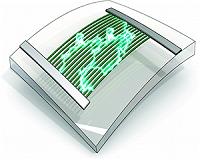 |
Oak Ridge TN (SPX) Sep 21, 2010 As industries and consumers increasingly seek improved battery power sources, cutting-edge microscopy performed at the Department of Energy's Oak Ridge National Laboratory is providing an unprecedented perspective on how lithium-ion batteries function. A research team led by ORNL's Nina Balke, Stephen Jesse and Sergei Kalinin has developed a new type of scanning probe microscopy called electrochemical strain microscopy (ESM) to examine the movement of lithium ions through a battery's cathode material. The research, "Nanoscale mapping of ion diffusion in a lithium-ion battery cathode" (Balke et al.), is published in Nature Nanotechnology. "We can provide a detailed picture of ionic motion in nanometer volumes, which exceeds state-of-the-art electrochemical techniques by six to seven orders of magnitude," Kalinin said. Researchers achieved the results by applying voltage with an ESM probe to the surface of the battery's layered cathode. "By measuring the corresponding electrochemical strain, or volume change, the team was able to visualize how lithium ions flowed through the material. Conventional electrochemical techniques, which analyze electric current instead of strain, do not work on a nanoscale level because the electrochemical currents are too small to measure, Kalinin explained. "These are the first measurements, to our knowledge, of lithium ion flow at this spatial resolution," Kalinin said. Lithium-ion batteries, which power electronic devices from cell phones to electric cars, are valued for their low weight, high energy density and recharging ability. Researchers hope to extend the batteries' performance by lending engineers a finely tuned knowledge of battery components and dynamics. "We want to understand - from a nanoscale perspective - what makes one battery work and one battery fail. This can be done by examining its functionality at the level of a single grain or an extended defect," Balke said. The team's ESM imaging can display features such as individual grains, grain clusters and defects within the cathode material. The high-resolution mapping showed, for example, that the lithium ion flow can concentrate along grain boundaries, which could lead to cracking and battery failure. Researchers say these types of nanoscale phenomena need to be examined and correlated to overall battery functionality. "Very small changes at the nanometer level could have a huge impact at the device level," Balke said. "Understanding the batteries at this length scale could help make suggestions for materials engineering." Although the research focused on lithium-ion batteries, the team expects that its technique could be used to measure other electrochemical solid-state systems, including other battery types, fuel cells and similar electronic devices that use nanoscale ionic motion for information storage. "We see this method as an example of the kinds of higher dimensional scanning probe techniques that we are developing at CNMS that enable us to see the inner workings of complex materials at the nanoscale," Jesse said. "Such capabilities are particularly relevant to the increasingly important area of energy research." Balke, Jesse and Kalinin are research scientists at ORNL's Center for Nanophase Materials Science. The research team includes Nancy Dudney, Yoongu Kim and Leslie Adamczyk from ORNL's Materials Sciences and Technology Division. The key theoretical results in the work were obtained by Anna Morozovska and Eugene Eliseev at the National Academy of Science of Ukraine and Tony Chung and Edwin Garcia at Purdue University. This research was supported as part of the Fluid Interface Reactions, Structures and Transport Center, an Energy Frontier Research Center funded by the Department of Energy, Office of Science.
Share This Article With Planet Earth
Related Links Center for Nanophase Materials Sciences Powering The World in the 21st Century at Energy-Daily.com
 Lead-Free Piezoelectric Materials Of The Future
Lead-Free Piezoelectric Materials Of The FutureWashington DC (SPX) Sep 21, 2010 Piezoelectric materials have fantastic properties: squeeze them and they generate an electrical field. And vice-versa, they contract or expand when jolted with an electrical pulse. With a name derived from the Greek word meaning to squeeze or press, the piezoelectric effect was just a curiosity after it was discovered in several crystals in 1880. But in 1917, a quartz piezoelectric crystal ... read more |
|
| The content herein, unless otherwise known to be public domain, are Copyright 1995-2010 - SpaceDaily. AFP and UPI Wire Stories are copyright Agence France-Presse and United Press International. ESA Portal Reports are copyright European Space Agency. All NASA sourced material is public domain. Additional copyrights may apply in whole or part to other bona fide parties. Advertising does not imply endorsement,agreement or approval of any opinions, statements or information provided by SpaceDaily on any Web page published or hosted by SpaceDaily. Privacy Statement |